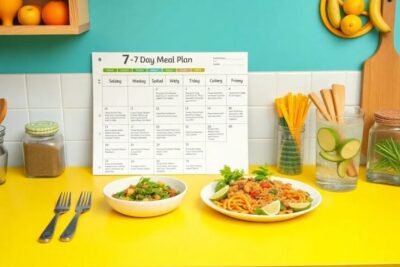
Diabetic-Friendly Options: Navigating Food Choices at Fast Food Restaurants
- Understanding Diabetes and Diet
- The Challenge of Eating Out with Diabetes
- Making Informed Choices: What to Look For
- Essential Nutrition Principles for Diabetic-Friendly Meals
- Top Diabetic-Friendly Food Suggestions
- Portion Control: The Key to Enjoying Your Meal
- Tips for Customizing Your Meal
- Navigating Online Resources for Meal Planning
- Community Support and Resources
Understanding Diabetes and Diet
Diabetes is a chronic medical condition characterized by elevated blood glucose levels, primarily due to the body's inability to produce or effectively use insulin. There are three main types of diabetes: Type 1, Type 2, and gestational diabetes. Type 1 diabetes occurs when the pancreas produces little or no insulin, necessitating regular insulin administration. In contrast, Type 2 diabetes, which is more prevalent, often arises from insulin resistance, where the body cannot effectively utilize the insulin available. Gestational diabetes manifests during pregnancy and usually resolves after childbirth but may increase the risk of developing Type 2 diabetes later in life.
A critical aspect of managing diabetes involves diet, particularly carbohydrate intake. Carbohydrates are the body's primary source of energy; however, they can significantly impact blood sugar levels. For individuals with diabetes, counting carbohydrates is vital for maintaining blood glucose within a target range. Understanding how various foods affect blood sugar levels helps in making informed dietary choices. Incorporating diabetic-friendly food at KFC or other fast food establishments requires careful consideration of the types of carbohydrates consumed.
Another essential concept in diabetes management is the glycemic index (GI), which categorizes foods based on their impact on blood sugar levels. Foods with a low glycemic index release glucose gradually into the bloodstream, avoiding spikes in blood sugar. Conversely, high-GI foods can cause rapid increases in blood sugar, which is particularly concerning for those managing diabetes. By selecting foods with a lower glycemic index, individuals can better regulate their blood glucose levels. Understanding the principles of carbohydrate counting and the glycemic index will empower individuals with diabetes to make healthier food choices, thus enhancing their quality of life.
The Challenge of Eating Out with Diabetes
For individuals managing diabetes, dining at fast food restaurants can present various challenges. The allure of convenient and quick meals often comes paired with dietary hurdles that necessitate careful consideration. A key aspect of this dilemma is understanding portion sizes, which can be misleading at many fast food venues. Meals are frequently served in larger portions, leading to an inadvertent increase in calorie and carbohydrate intake, both of which can significantly impact blood sugar levels for those with diabetes.
Another significant hurdle is the presence of hidden sugars in various menu items. Sauces, dressings, and even seemingly healthy options may contain added sugars that are not immediately apparent. For instance, a salad might appear to be a diabetic-friendly option at first glance, but if drizzled with a sugar-laden dressing, it can quickly become a less suitable choice. This makes it imperative for diabetics to be well-informed about ingredient lists and nutritional content when considering fast food choices.
The temptation of indulgent menu items poses an additional challenge. Special promotions and enticing advertisements spotlight meals that are often high in sugar and unhealthy fats. For someone who has to adhere to strict dietary constraints, these temptations can be overwhelming, potentially leading to choices that conflict with their health goals. Consequently, understanding how to navigate these enticing menus is essential for making informed decisions that align with maintaining stable blood sugar levels.
Despite these challenges, it is possible to find diabetic-friendly food at KFC and similar establishments. This requires a proactive approach, asking questions about ingredients, and opting for alternatives that provide nutritional value without compromising on taste. By arming themselves with knowledge and remaining mindful of their choices, individuals with diabetes can enjoy dining out while still adhering to their dietary needs.
Making Informed Choices: What to Look For
When dining out, especially at fast food restaurants like KFC, making informed choices is crucial for individuals managing diabetes. Understanding key terms and menu options can substantially aid in selecting diabetic-friendly food at KFC and similar establishments. Here are some essential tips to consider when reviewing menus or recommending meals.
Firstly, prioritize items that are labeled as 'low-carb.' Such options are generally more suitable for those monitoring their carbohydrate intake, which is critical for blood sugar control. Fast food menus often incorporate this terminology, allowing patrons to quickly identify healthier selections. Additionally, meal components that are grilled rather than fried tend to have fewer calories and unhealthy fats, making grilled items an ideal choice for diabetic-friendly dining.
Secondly, consider how to customize your meal effectively. Many fast food restaurants, including KFC, offer the possibility to modify orders. Requesting salads instead of fries or asking for dressings on the side can significantly enhance the healthiness of your meal. Moreover, inquiring about portion sizes can further assist in managing carbohydrate intake. Requesting smaller portions or half servings may prevent overeating without sacrificing satisfaction.
Another important aspect to keep in mind is the presence of sauces and dressings which can add hidden sugars and carbs to a meal. Opt for mustard or vinegar-based dressings, which are usually lower in sugar content, especially when selecting diabetic-friendly food at KFC. Additionally, avoiding items with sweet glazes or sauces can help maintain balanced blood sugar levels.
Lastly, remain informed about the nutritional content of your choices. Many fast food chains provide nutritional information both online and in-store. Familiarizing yourself with the calorie, carbohydrate, and fat contents of various offerings can empower you to make healthier choices without feeling deprived.
Essential Nutrition Principles for Diabetic-Friendly Meals
When managing diabetes, understanding essential nutrition principles is crucial for maintaining healthy blood sugar levels. The cornerstone of a diabetic-friendly diet lies in achieving a balanced macronutrient intake, which includes carbohydrates, proteins, and fats. Carbohydrates should be monitored closely as they have a direct impact on blood glucose levels. Opting for complex carbohydrates, such as whole grains, legumes, and vegetables, is advisable over simple sugars, as these provide sustained energy and cause a slower rise in blood sugar.
Proteins are fundamental in any diabetic-friendly meal plan. They not only aid in muscle maintenance but also provide a sense of fullness, which can prevent overeating. Sources of lean protein such as poultry, fish, and plant-based options like beans and lentils can be incorporated. Additionally, healthy fats are essential for overall health and should not be neglected. Incorporating foods rich in omega-3 fatty acids, such as flaxseeds and walnuts, as well as monounsaturated fats from sources like olive oil and avocados, can contribute positively to heart health and satiety.
Fiber intake is another critical aspect to consider. High-fiber foods help regulate blood sugar levels and enhance digestive health. Foods such as fruits, vegetables, whole grains, and legumes are excellent sources of dietary fiber. Including these in meals can slow digestion and absorption of carbohydrates, which is beneficial for blood sugar control. For example, when dining at fast food establishments, it is important to select options that incorporate fiber-rich ingredients where available.
In summary, adhering to these nutrition principles can help individuals with diabetes make informed food choices, including exploring diabetic-friendly food at KFC. By balancing macronutrients, consuming adequate fiber, and incorporating healthy fats, individuals can create satisfying meals that promote better health outcomes.
Top Diabetic-Friendly Food Suggestions
For individuals managing diabetes, finding suitable meal options at fast-food restaurants can be a daunting task. However, restaurants like KFC offer various diabetic-friendly food choices that cater to their dietary needs without compromising flavor. A crucial aspect of selecting options is to focus on items that are lower in carbohydrates and sugars while rich in nutrients.
At KFC, one of the standout choices is the grilled chicken, which provides a great source of protein with significantly fewer carbohydrates compared to the fried counterparts. Grilled chicken can be paired with green beans or corn on the cob for a balanced meal, allowing individuals with diabetes to enjoy their dining experience while maintaining their dietary restrictions.
Another diabetic-friendly option at KFC includes their house side salads. These salads, often topped with grilled chicken, are low in calories and carbohydrates. Choosing dressing wisely is vital; opting for vinaigrettes over creamy dressings can further lower sugar intake, making it a suitable option for those watching their carbohydrate levels.
Furthermore, KFC's mashed potatoes can also be considered in moderation. While they contain some carbohydrates, when consumed in small portions, they can fit into a balanced meal plan. It is crucial to avoid gravy, which can add unwanted sugars and calories.
Lastly, for those seeking a lighter option, KFC offers the popcorn chicken in a grilled variety, which is not only flavorful but also lower in calories and carbohydrates. This particular choice allows individuals to enjoy the crunch without the excessive fat often found in fried foods.
For anyone seeking diabetic-friendly food at KFC, it is essential to remember portion control and make balanced selections of sides. By carefully choosing menu items, individuals can maintain their dietary guidelines while enjoying their experience at fast food establishments.
Portion Control: The Key to Enjoying Your Meal
Managing diabetes requires vigilance, particularly when dining out. One crucial aspect of maintaining blood sugar levels is portion control. By understanding and implementing strategies for managing food intake, individuals with diabetes can enjoy meals at fast-food restaurants like KFC without compromising their health.
When considering diabetic-friendly food at KFC or any fast-food establishment, it is vital to be mindful of the quantities served. High portion sizes can lead to excessive calorie and carbohydrate intake, which may disrupt blood sugar management. A simple yet effective strategy is to share meals with others. By splitting a larger portion, diners can reduce their intake while still enjoying the flavors of their chosen meal.
Another useful tip involves taking half the meal home. This approach not only helps in controlling portion sizes but also ensures that there is a meal ready for later, promoting healthy eating habits over multiple days. Additionally, customers can opt for smaller sizes or kid's meals when available. These options typically provide enough food to satisfy hunger while being compliant with one’s dietary needs.
It is also beneficial to pay attention to the components of the meal. Combining a smaller portion of a carb-rich item with an abundance of vegetables increases satiety and provides essential nutrients. At KFC, for instance, ordering a grilled chicken salad instead of a fried item allows for a more balanced meal while adhering to portion guidelines. Making conscious choices while dining out not only supports blood sugar stabilization but also enriches the overall dining experience.
Ultimately, portion control is an essential strategy for individuals with diabetes. By practicing moderation and using practical tips, one can navigate fast food options successfully while enjoying the flavors of meals at establishments such as KFC.
Tips for Customizing Your Meal
When navigating food choices at fast food restaurants, particularly those like KFC, it's essential to customize your meal to accommodate dietary needs, especially for individuals managing diabetes. The first step is to inquire about the specific ingredients in the dishes you are considering. Understanding what components contribute to carbohydrate content can significantly aid in making informed choices. Opt for grilled options rather than fried whenever possible; grilled chicken is often lower in calories and fat, making it a more suitable choice for a diabetic-friendly meal.
Requesting modifications can make a significant difference. For instance, you may ask for sauces, dressings, and toppings on the side, which allows you to control portion sizes and avoid unnecessary sugar or calorie intake. KFC provides several options, and selecting a light dressing or using vinegar and oil can enhance your meal without adding high levels of sugar. Additionally, consider swapping out traditional sides for healthier alternatives. Many fast-food restaurants, including KFC, offer vegetables or side salads that can be more appropriate for a diabetic-friendly diet.
Portion control can also contribute to managing blood sugar levels effectively. If the meal sizes are large, consider asking for a smaller portion or sharing with someone else. By focusing on the carbohydrate content of each item, you can balance your meal with appropriate servings of protein and fiber, both beneficial for maintaining stable blood sugar. Finally, staying hydrated is crucial; choose water or unsweetened iced tea instead of sugary drinks or soda to further enhance your meal’s diabetic-friendly profile.
By following these tips for customization, you can make informed choices that align with your dietary needs while enjoying meals at KFC or other fast food establishments. Taking control of your dining experience empowers you to maintain a diabetic-friendly diet without sacrificing the enjoyment of eating out.
In the digital age, a myriad of online resources are available to assist individuals managing diabetes in their meal planning endeavors. Utilizing these tools can significantly aid those seeking to incorporate diabetic friendly food at KFC or any other fast-food establishments into their dietary routine. From nutritional databases to mobile applications, these resources can empower users to make informed choices that comply with their dietary needs.
First and foremost, one can find reputable websites dedicated to providing comprehensive nutritional information. Sites such as the American Diabetes Association offer educational content that includes meal planning tips, dietary guidelines, and information on carbohydrate counting. These resources can help individuals understand how certain foods, including those from KFC, fit into their overall meal plans. It is essential to look for trusted sources that not only provide current nutritional data but also consider the specific needs associated with managing diabetes.
In addition to websites, meal-planning apps can be particularly beneficial for ongoing dietary management. Applications like MyFitnessPal or Carb Manager not only allow users to track their daily food intake but also provide convenient tools to calculate carbohydrates effectively. These apps often come equipped with extensive food databases, which help users identify diabetic friendly food at KFC by searching for menu items and their nutritional profiles directly within the app.
Moreover, leveraging calculators available on some nutrition-focused sites can facilitate precise carbohydrate counts, ensuring that meal planning aligns with individual dietary goals. These calculators can provide insights into various menu items and help users find suitable options that fit their lifestyle. Overall, dedicated online resources can play a vital role in the journey towards healthier meal choices, especially when navigating fast-food outlets.
Community Support and Resources
Managing diabetes can be a challenging journey, but individuals need not go through it alone. Community support plays a crucial role in helping those with diabetes make informed dietary choices and stay motivated. Many resources exist, both locally and online, that can provide valuable assistance, encouragement, and connections between individuals facing similar challenges.
Local diabetes support groups are an excellent way for individuals to meet others who understand the complexities of living with diabetes. These groups often host meetings where members can share experiences, discuss diabetic friendly food options, and exchange useful strategies. Community centers, hospitals, and diabetes clinics frequently organize these gatherings. Additionally, some groups may offer cooking classes focusing on creating diabetic friendly meals, enhancing participants' cooking skills while ensuring they meet their dietary needs.
Online forums and social media platforms also serve as integral resources. Websites dedicated to diabetes management often feature discussion boards where individuals can ask questions, seek advice, and share their experiences. Facebook groups and Instagram hashtags dedicated to diabetes support provide a space for the community to connect, share recipes, and discover alternatives for fast food, including diabetic friendly food at KFC. These platforms help individuals feel less isolated and more empowered in their journey.
Meal-sharing programs, such as those organized by local churches or nonprofit organizations, can also foster community involvement. These initiatives allow individuals to prepare and exchange meals while promoting healthy recipes suitable for those managing diabetes. This not only helps to alleviate the stress of meal planning but encourages socialization and support among participants.
By tapping into these resources, individuals managing diabetes can enhance their knowledge of diabetic friendly food options while building a network of support that encourages a healthy lifestyle.










